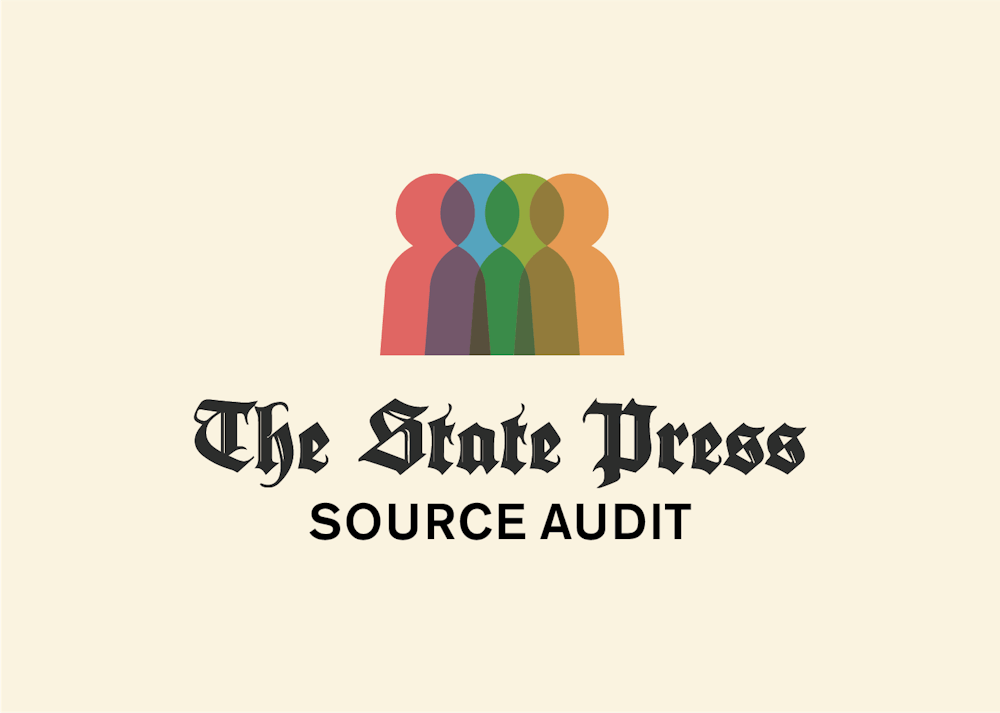The State Press is publishing its first-ever source audit.
We spent the Fall 2020 semester recording demographic information about our sources with the goal of publishing a final report on our site detailing these findings. Collecting this information from the people we source holds our newsroom accountable to not just ourselves but our readers.
Unfortunately, we were not able to publish an audit in Fall 2020 due to an insufficient amount of data to analyze. The lack of data was caused by many published articles missing source audits.
One way we fixed this in the spring semester was by diligently reminding all reporters to complete the source audit form weekly and by compiling a list of articles that were missing source audits.
For the current semester, we changed the way we recorded sources' religions. The data we collected on sources' religions for Spring 2021 was not fully representative of our sources due to a data collection error in that specific section of the audit, and we have fixed the problem for future reports.
We are continuing this practice in the fall to improve the accuracy of our data. Our goal is to ensure we provide an accurate and transparent representation of whom we source.
Local newsrooms across the country have also begun to publish audits as a wake-up call for reporters to strive for more equitable sourcing. The journalism industry has long failed to diversify its newsrooms and the voices it chooses to amplify.
Every semester, we ask our State Press staff to fill out a demographic survey so we may understand the diversity of our newsroom. For the Spring 2021 semester, 74.3% of State Press staff members who responded said they were white, followed by 21.9% identifying as Hispanic or Latine, 17.1% as Asian, 5.7% as Black, 4.8% as Middle Eastern/North African, 3.8% as Pacific Islander and 2.9% as Native American.
Of our newsroom staff, 55.2% were female, 38.1% were male and 6.7% were nonbinary.
For the Spring 2021 semester, we recorded a total of 721 sources for the audit across our digital and multimedia desks and our magazine. Reporters asked sources to identify themselves by their race/ethnicity, gender, pronouns, job field and age.
The audit only includes sources our reporters have personally reached out to and spoken with (not including press releases, press conferences, public meetings or other large-scale events). All sources in the audit remain anonymous, and all sources were given the option to not respond to questions.
There is no longer a hope, but a genuine obligation for our sourcing to reflect the communities we cover. The State Press, like all other newsrooms, needs to overcome its shortcomings in order to serve its audience to the very best of its abilities. By no means are we proud of our sourcing, but we are committed to using the source audit as a form of transparency and to move us forward to where we need to be.
Race/Ethnicity
Last fall, we made the question about sources' races and ethnicities open-ended. With the spring audit, we decided to add choices to make it easier to keep an accurate count.
The majority of our sources in the spring, nearly 55%, were white.
Latine was the second-largest racial/ethnic group for our sources, making up 12.2% of our sources. For the third-largest racial/ethnic group, 11.4% of our sources identified as Asian, not including Pacific Islander people.
Sources who identified as Black/African American made up 10.7%, Middle Eastern/North African made up 2.1% and Indigenous/Native American made up just 1%.
To make the graph more readable, we took the 7.6% of respondents who said they identified with two or more races and included the data in a separate chart. Of the 7.6%, nearly a third of sources identified as white and Latine, followed by 20% of sources who said they were white and Asian.
Out of all the sources who answered, only 0.8% of respondents identified as white and Black, and 0.4% of respondents were Indigenous and Latine.
For the Fall 2021 semester, we added some new choices: multiracial, Asian, Pacific Islander and Hispanic.
There was a large number of sources who identified as more than one race. We decided to separate Pacific Islander from Asian to ensure that Pacific Islander voices are being represented in our community. Hispanic was also included to include Brazilians and other non-Spanish speaking people from Latin America.
Gender
The majority of our sources, 52.3%, were female. Approximately 44.6% were male, and 2.5% were nonbinary.
Other answers included questioning, transgender man and female/nonbinary, which combined to make up 0.5% of the responses.
Pronouns
Over half of our respondents, 51.4%, use she/her pronouns, and 43.7% use he/him pronouns. The remaining 4.9% of respondents used a variety of pronouns, including they/them, she/they or he/her.
Job field
For the job field category, we asked respondents to choose what field they were involved in, ranging from student to specific fields, such as engineering and law.
Nearly half of our sources were students. The next highest occupation was education, which was 13.9%. Education included ASU faculty members, deans and instructors. University administrators made up 8.8% of our sources.
For new changes, we added University faculty and staff to further ensure accuracy in this fall's source audit.
Age
For age, we asked sources to identify their age range rather than focusing on a specific age.
Over half of our sources fell between 18-23 years old, followed by just under 13% of sources in the 31-40 year age range.
Final thoughts
The State Press is currently working on its source audit for the Fall 2021 semester. Our goal is to reach out to communities that have lower representation in the Spring 2021 audit to ensure fair coverage. Based on the responses from this past semester's audit, we have added new categories in race, religion and job occupations.
We will continue our weekly reminders for reporters to complete the audits in order to improve our data collection and accuracy.
Overall, the audit has shown us that our work is not complete, and we need to improve our coverage of historically underrepresented communities in order to have all voices represented and shared through our work.
The State Press will be hosting its second town hall on Oct. 21 at 4:30 p.m. on the third floor of the Memorial Union and via Zoom. We welcome anyone to attend and ask questions, learn more about our newsroom or meet the reporters and editors behind the work.
Reach the diversity officer for the Fall 2021 semester at anatar12@asu.edu or follow @AnushaNat1 on Twitter. Reach the Spring 2021 diversity officer at feltoham@asu.edu and on Twitter @farahelto.
Like The State Press on Facebook and follow @statepress on Twitter.
Continue supporting student journalism and donate to The State Press today.





